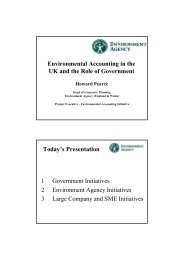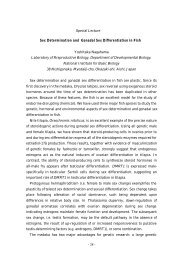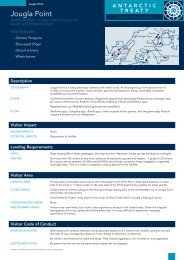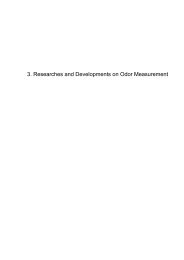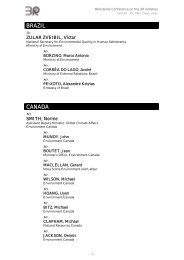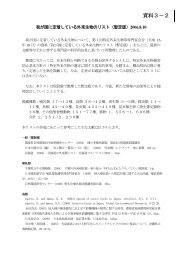The medaka (Oryzias latipes) Full Life-Cycle Test Guideline
The medaka (Oryzias latipes) Full Life-Cycle Test Guideline
The medaka (Oryzias latipes) Full Life-Cycle Test Guideline
You also want an ePaper? Increase the reach of your titles
YUMPU automatically turns print PDFs into web optimized ePapers that Google loves.
<strong>Test</strong> animals<br />
4. This test should be started with embryos within several hours post-fertilization from a ready supply of known-quality<br />
animals. Candidate species for this assay include <strong>medaka</strong> (<strong>Oryzias</strong> <strong>latipes</strong>), fathead minnow (Pimephales promelas),<br />
sheepshead minnow (Cyprinodon variegatus) and zebrafish (Danio rerio). Relevant modification is necessary for test fish<br />
species other than <strong>medaka</strong>. Field-collected fish generally should not be used to initiate cultures for the testing.<br />
5. Parental fish for the spawning eggs subjected to exposure should be selected from a population of a single stock. <strong>The</strong><br />
fish should be paired and acclimatized for at least two weeks prior to the test under conditions of water quality and<br />
illumination similar to those used in the test (Annex 1). Fish should be fed exclusively with Artemia nauplii (
11. <strong>Test</strong> solutions of the chosen concentrations are prepared by dilution of a stock solution. <strong>The</strong> stock solution should<br />
preferably be prepared by simply mixing or agitating the test substance in the dilution water by using mechanical means<br />
(e.g. stirring or ultrasonication). Saturation columns can be used for achieving a suitable concentrated stock solution. It is<br />
recommended that, whenever possible, solvents not be used to generate stock solutions for conducting chemical exposures<br />
via the water.<br />
12. In some cases it may be necessary to use solvents to generate stock solutions for aqueous testing; this could occur<br />
when a chemical is very insoluble, unstable in a saturator system, or so expensive/limited in availability that the use of<br />
saturators is not practical. Generally, examples of suitable solvents in fish chronic toxicity test are acetone,<br />
dimethylformamide, dimethylsulfoxide, ethanol, methanol and triethylene glycol. However, there are relatively few studies<br />
on the possible effects of these solvents on the fish endocrine system. Hence, it is essential that any test utilizing a carrier<br />
solvent include both solvent-exposed and non-exposed controls.<br />
- A new section on dietary exposure would be useful<br />
Analytical determination and measurements<br />
13. During the test, the concentrations of the test substance are determined at appropriate intervals (e.g. every other<br />
week in each of the test treatments).<br />
14. During the test, the flow rates of diluent and stock solution should be checked at intervals accordingly (e.g. five times<br />
a week). It is recommended that the test substance concentrations fall within ± 20 % of nominal values (i.e. within the<br />
range 80-120 %). If the concentrations of the test substance are not maintained within ± 20 % of nominal values, it is<br />
preferable within ± 20 % of mean measured values. However, in case of some chemicals which can markedly accumulate in<br />
fish body, the concentrations of the test substance may be decreased depending on fish growth. In that case, it is<br />
recommended that renewal rate of the test solution in each chamber be raised.<br />
15. It is recommended that results be based on measured concentrations. However, if evidence is available to demonstrate<br />
that the concentration of the test substance has been satisfactory maintained within ± 20 % of the nominal, the results can<br />
be based on nominal or measured values.<br />
16. During the test, dissolved oxygen, pH, and temperature should be measured in one test vessel of all treatment groups<br />
and the controls. As a minimum, these measurements should be measured once a week through the exposure periods.<br />
PERFORMANCE OF THE TEST<br />
Embryological phase<br />
17. Exposure should be initiated shortly after fertilization (at the latest, < several hours post-fertilization). <strong>The</strong> 60<br />
embryos employed for each treatment are randomly separated into four groups of 15 for testing in quadruplicate. Each<br />
group of embryos may be placed directly in the test chamber or in a cylindrical glass egg cup (e.g. diameter, 5 cm; depth,<br />
10 cm), which is covered with stainless steel mesh (e.g. No. 32) on the bottom. If the egg cups are used, these may be<br />
swung vertically at a slow pace (e.g. 20-25 times/min.) in the test chamber. <strong>The</strong> developing embryos should be observed<br />
daily under a stereoscopic microscope. Any dead embryo should be discarded; live ones should be returned to the chamber.<br />
This procedure should be repeated until all the living embryos have hatched. Generally, hatchability and time to hatch of<br />
<strong>medaka</strong> in the controls at 24 °C are ≥ 90 % and 9-10 d, respectively (Yokota et al, 2000; Yokota et al, 2001a).<br />
Larval-juvenile phase<br />
18. After hatching, the larvae should be fed an adequate amount of Artemia nauplii (
25. VTG is an estrogen-dependent glycoprotein which is usually only synthesized in the liver of mature females (Denslow<br />
et al, 1999). <strong>The</strong>refore, when detected in the serum of male fish, VTG can be used as a biomaker of exposure to estrogenic<br />
chemicals in a variety of fish species, including <strong>medaka</strong> (Gronen et al, 1999; Metcalfe et al, 2000; Yokota et al, 2001b;<br />
Kang et al, 2002; Seki et al, 2002), fathead minnow (Ankley et al, 2001; Harries et al, 2000; Panter et al, 1998; Kramer<br />
et al, 1998; Parks et al, 1999; Tyler et al, 1999), and rainbow trout (Jobling et al, 1996; Thorpe et al, 2000). Different<br />
methods are available to assess VTG production in fish; a measurement technique that is both relatively sensitive and<br />
specific is determination of protein concentrations in plasma or liver via ELISA or radioimmunoassay (RIA). For ELISA,<br />
monoclonal <strong>medaka</strong> VTG antibody and purified VTG protein from <strong>medaka</strong> are utilized (Yokota et al, 2001b). In fathead<br />
minnow, polyclonal fathead minnow VTG antibody and VTG protein have also been purified (Korte et al, 2000; Parks et<br />
al, 1999). Until now, the VTG induction assay using plasma have been developed and validated in fathead minnow (Tyler et<br />
al, 1999; Ankley et al, 2001) and rainbow trout (Thorpe et al, 2000). In small fish species such as <strong>medaka</strong>, collecting the<br />
plasma is technically difficult. <strong>The</strong>refore hepatic VTG induction assay have been developed and validated in <strong>medaka</strong><br />
(Yokota et al, 2001b).<br />
F1 embryo phase<br />
26. Eggs spawned by females in the last 3 d of the reproductive trial (98 to 100-d posthatch) should be subjected to the<br />
exposure study of the progeny generation (F1). To evaluate their hatchability and time to hatch, the fertilized eggs from<br />
each spawning in treatment groups and in the controls should be collected and exposed until hatching, under the same flowthrough<br />
conditions as those used for the F0 generation.<br />
F1 larval–juvenile phase<br />
27. <strong>The</strong> newly hatched larvae in the treatments and the controls should be randomly transferred to four test chambers in<br />
each treatment and kept in the chambers until the last hatching. <strong>The</strong>n 15 larvae in each chamber should randomly be<br />
selected (60 larvae in each treatment group). <strong>The</strong>n they may be treated until 60-d posthatch in the same flow-through<br />
system for the F0 generation. <strong>The</strong> fish should be checked daily until 60-d posthatch for mortality, abnormal behavior, and<br />
appearance. Dead fish should be removed as soon as possible. At 60-d posthatch, the external secondary sex characteristics<br />
of all the surviving F1 fish should be observed, and their weights and lengths should be measured after overdosing with<br />
anesthetic. <strong>The</strong>y should be fixed and prepared for the gonadal histology. Some estrogenic chemicals can have adverse<br />
effects at lower concentrations in the progeny than in their parent generations (Yokota et al, 2001a; Seki et al, 2002<br />
[submitted]). Further work to elucidate the enhanced response in the progeny by transgenerational exposure need to be<br />
investigated.<br />
VALIDITY OF THE TEST<br />
28. This test has not been performed extensively, but based on our study with <strong>medaka</strong> to date, we suggest the following<br />
criteria for the test acceptability:<br />
- the dissolved oxygen concentration must be between 60 and 100 % of the air saturation value throughout the test;<br />
- the water temperature must not differ by more than ± 2.0 °C between test chamber or between successive days at any<br />
time during the test;<br />
- there should be more than 80 % survival of control animals after hatching through 60-d posthatch in each F0 and F1<br />
generation.<br />
29. As experience is gained with this test, additional biological performance criteria can be incorporated.<br />
DATA REPORTING<br />
Statistical analysis<br />
30. <strong>The</strong> primary goal of the data analyses are to calculate the No-Observed Effect Concentration and the Lowest<br />
Observed Effect Concentration based on potentially adverse population relevant effects (NOECadverse and LOECadverse,<br />
respectively). <strong>The</strong>se calculations should address the effects on survival, gross development, growth and reproduction.<br />
Secondarily, the data for VTG, GSI and gonad histology may be used to calculate the No-Observed Effect Concentration<br />
and the Lowest Observed Effect Concentration based on mechanistic biomarker reponses (NOECbiomarker and LOECbiomarker,<br />
respectively).<br />
New paragraph. Different options are available for data analysis, we suggest the following flow acceptability; If carrier<br />
solvent is used in the test, appropriate analytical method may be used prior to data analysis to determine whether there are<br />
5
differences between the solvent control and control groups. If no differences are found, these groups are pooled for<br />
subsequent analysis. If differences are found, the control group without solvent is excluded from the subsequent analyses<br />
because of few studies on the possible effects of the solvents on the fish endocrine system. To identify potential endocrine<br />
activity by a chemical, biological responses except for sex ratios may be compared between in treatments versus controls<br />
groups using analysis of variance (ANOVA) followed by multiple comparison test (e.g. Dunnett’s multiple comparison<br />
test). If the required assumptions for parametric methods are not met, non-parametric test may be conducted. <strong>The</strong> data on<br />
sex ratios may be assessed by chi-squared analysis.<br />
31. Any endpoints that are significantly impacted by the test chemical should be reported.<br />
<strong>Test</strong> report<br />
32. <strong>The</strong> test report must include the following:<br />
<strong>Test</strong> substance:<br />
- physical nature and, where relevant, physicochemical properties;<br />
- chemical identification data.<br />
<strong>Test</strong> species:<br />
- scientific name, strain, source and method of collection of the fertilized eggs and subsequent handling.<br />
<strong>Test</strong> conditions:<br />
- photoperiod(s);<br />
- test design (e.g. chamber size, number of test chambers and replicates, number of embryos per replicates);<br />
- method of preparation of stock solutions and frequency of renewal (the solubilising agent and its concentration must<br />
be given, when used);<br />
- the nominal test concentrations, the means of the measured values and their standard deviations;<br />
- dilution water characteristics: pH, hardness, temperature, dissolved oxygen concentration, residual chlorine levels (if<br />
measured), total organic carbon, suspended solids and other measurements made;<br />
- water quality within test vessels, pH, temperature and dissolved oxygen concentration;<br />
- detailed information on feeding (e.g. type of foods, source, amount given and frequency).<br />
Results:<br />
- Data for the control (plus solvent control when used) and the treatment groups as follows, embryological<br />
development, hatching (hatchability and time to hatch), posthatch survival, growth (total length and body weight),<br />
sexual differentiation (secondary sex characteristics and gonadal histology), reproduction (fecundity and fertility),<br />
gonadosomatic index (GSI) and hepatic vitellogenin (VTG);<br />
- Statistical analysis used and results of this.<br />
LITERATURE<br />
Ankley GT, Jensen KJ, Kahl MD, Korte JJ, Makynen EA. 2001. Description and evaluation of a short-term reproduction<br />
test with the fathead minnow (Pimephales promelas). Environ Toxicol Chem 20:1276–1290.<br />
Benoit DA, Mattson VR, Olson DL. 1982. A continuous-flow mini-diluter system for toxicity testing. Water Res 16:457–<br />
464.<br />
Denslow ND. 1999. Vitellogenin as a biomaker of exposure for estrogen or estrogen mimics. Ecotoxicology 8:385-398.<br />
Egami N. 1955. Production of testis-ova in adult males of <strong>Oryzias</strong> <strong>latipes</strong> I. <strong>Test</strong>is-ova in the fish receiving estrogens. Jpn<br />
J Zool 11:353–365.<br />
6
Gary MA, Metcalfe CD. 1997. Induction of testis-ova in Japanese <strong>medaka</strong> (<strong>Oryzias</strong> <strong>latipes</strong>) exposed to p-nonylphenol.<br />
Environ Toxicol Chem 16:1082–1086.<br />
Gray MA, Niimi AJ, Metcalfe CD. 1999a. Factors affecting the development of testis-ova in <strong>medaka</strong>, <strong>Oryzias</strong> <strong>latipes</strong>,<br />
exposed to octylphenol. Environ Toxicol Chem 18:1835–1842.<br />
Gray MA, Teather KL, Metcalfe CD. 1999b. Reproductive success and behavior of Japanese <strong>medaka</strong> (<strong>Oryzias</strong> <strong>latipes</strong>)<br />
exposed to 4-tert-octylphenol. Environ Toxicol Chem 18:2587–2594.<br />
Gronen S, Denslow N, Manning S, Barnes S, Barnes D, Brouwer M. 1999. Serum vitellogenin levels and reproductive<br />
impairment of male Japanese <strong>medaka</strong> (<strong>Oryzias</strong> <strong>latipes</strong>) exposed to 4-tert-octylphenol. Environ Health Perspect 107: 385-<br />
390.<br />
Harries JE, Runnalls T, Hill E, Harris C, Maddix S, Sumpter JP, Tyler CR. 2000. Development of a reproductive<br />
performance test for endocrine disrupting chemicals using pair-breeding fathead minnows (Pimephales promelas). Environ<br />
Sci Technol 34:3003-3011.<br />
Jobling S, Sheahan D, Osborne JA, Matthiessen P, Sumpter JP. 1996. Inhibition of testicular growth in rainbow trout<br />
(Oncorhynchus mykiss) exposed to estrogenic alkylphenolic chemicals. Environ Toxicol Chem 15:194–202.<br />
Kang IJ, Yokota H, Oshima Y, Tsuruda Y, Yamaguchi T, Maeda M, Imada N, Tadokoro H, Honjo T. 2002. Effects of 17βestradiol<br />
on the reproduction of Japanese <strong>medaka</strong> (<strong>Oryzias</strong> <strong>latipes</strong>). Chemosphere 47:71–80.<br />
Katsiadaki I, Scott AP, Hurst M, Matthiessen PM, Mayer I. 2002. Detection of environmental andrgens: a novel method<br />
based on ELISA of spigin, the stickleback glue protein. Environ Toxicol Chem 21: 1946-1954<br />
Koger CS, Teh SJ, Hinton DE. 1999. p-Tert-octylphenol and/or vinclozolin induced-intersex in developing <strong>medaka</strong><br />
(<strong>Oryzias</strong> <strong>latipes</strong>). Society of Toxicology 1999 Annual Meeting, New Orleans, LA, p.268.<br />
Korte JJ, Kahl MD, Jensen KM, Pasha MS, Parks LG, LeBlanc GA, Ankley GT. 2000. Fathead minnow vitellogenin:<br />
complementary DNA sequence and messenger RNA and protein expression after 17β-estradiol treatment. Environ Toxicol<br />
Chem 19:972–981.<br />
Kramer VJ, Miles-Richardson S, Pierens SL, Giesy JP. 1998. Reproductive impairment and induction of alkaline-labile<br />
phosphate, a biomarker of estrogen exposure, in fathead minnows (Pimephales promelas) exposed to warterborne 17βestradiol.<br />
Aquat Toxicol 40:335–360.<br />
Länge R, Hutchinson TH, Croudace CP, Siegmund F, Schweinfurth H, Hampe P, Panter GH, Sumpter JP. 2001. Effects of<br />
the synthetic estrogen 17α-ethinylestradiol on the life-cycle of the fathead minnow (Pimephales promelas). Environ<br />
Toxicol Chem 20:1216–1227.<br />
Metcalfe TL, Metcalfe CD, Kiparissis Y, Niimi AJ, Foran CM, Benson WH. 2000. Gonadal development and endocrine<br />
responses in Japanese <strong>medaka</strong> (<strong>Oryzias</strong> <strong>latipes</strong>) exposed to o,p'-DDT in water or through maternal transfer. Environ<br />
Toxicol Chem 19:1893–1900.<br />
Metcalfe CD, Metcalfe TL, Kiparissis Y, Koenig BG, Khan C, Hughes RJ, Croley TR, March RE, Potter T. 2001.<br />
Estrogenic potency of chemicals detected in sewage treatment plant effluents as determined by in vivo assays with<br />
Japanese <strong>medaka</strong> (<strong>Oryzias</strong> <strong>latipes</strong>). Environ Toxicol Chem 20:297–308.<br />
Panter GH, Thompson RS, Sumpter JP. 1998. Adverse reproductive effects in male fathead minnows (Pimephales<br />
promelas) exposed to environmentally relevant concentrations of the natural oestrogens, oestradiol and oestrone. Aquat<br />
Toxicol 42:243-253.<br />
Parks LG, Cheek AO, Denslow ND, Heppell SA, McLachlan JA, LeBlanc GA, Sullivan CV. 1999. Fathead minnow<br />
(Pimephales promelas) vitellogenin: Purification, characterization, and quantitative immunoassay for the detection of<br />
estrogenic compounds. Comp Biochem Physiol 132C:113-125.<br />
7
Seki M, Yokota H, Matsubara H, Tsuruda Y, Maeda M, Tadokoro H, Kobayashi K. 2002. Effect of ethinylestradiol on the<br />
reproduction and induction of vitellogenin and testis-ova in <strong>medaka</strong> (<strong>Oryzias</strong> <strong>latipes</strong>). Environ Toxicol Chem 21: (in press).<br />
Seki M, Yokota H, Matsubara H, Maeda M, Tadokoro H, Kobayashi K. 2002. Fish full life-cycle testing of the weak<br />
estrogen 4-tert-pentylphenol in <strong>medaka</strong> (<strong>Oryzias</strong> <strong>latipes</strong>) Environ Toxicol Chem : (submitted).<br />
U.S. Environmental Protection Agency. 1986. Fish life-cycle toxicity tests; Hazard Evaluation Division Standard<br />
Procedure EPA 540/9–86–137; Office of Pesticide Programs: Washington, USA.<br />
Scholz S, Gutzeit HO. 2000. 17-α-ethinylestradiol affects reproduction, sexual differentiation and aromatase gene<br />
expression of the <strong>medaka</strong> (<strong>Oryzias</strong> <strong>latipes</strong>). Aquat Toxicol 50:363–373.<br />
Thorpe KL, Hutchinson TH, Hetheridge MJ, Sumpter JP, Tyler CR. 2000. Development of an in vivo screening assay for<br />
estrogenic chemicals using juvenile rainbow trout (Oncorhynchus mykiss). Environ Toxicol Chem 19:2812–2820.<br />
Tyler CR, Aerle RV, Hutchinson TH, Maddix S, Trip H. 1999. An in vivo testing system for endocrine disruptors in fish<br />
early life stages using induction of vitellogenin. Environ Toxicol Chem 18:337–347.<br />
Wester PW, Canton JH. 1986. Histopathological study of <strong>Oryzias</strong> <strong>latipes</strong> (<strong>medaka</strong>) after long-term βhexachlorocyclohexane<br />
exposure. Aquat Toxicol 9:21-45.<br />
Yamamoto T. 1965. Estriol-induced XY females of the <strong>medaka</strong> (<strong>Oryzias</strong> <strong>latipes</strong>) and their progenies. Gen Comp<br />
Endocrinol 5:527–533.<br />
Yokota H, Tsuruda Y, Maeda M, Oshima Y, Tadokoro H, Nakazono A, Honjo T, Kobayashi K. 2000. Effect of bisphenol<br />
A on the early life stage in Japanese <strong>medaka</strong> (<strong>Oryzias</strong> <strong>latipes</strong>). Environ Toxicol Chem 19:1925–1930.<br />
Yokota H, Seki M, Maeda M, Oshima Y, Tadokoro H, Honjo T, Kobayashi K. 2001a. <strong>Life</strong>-cycle toxicity of 4nonylphenol<br />
to <strong>medaka</strong> (<strong>Oryzias</strong> <strong>latipes</strong>). Environ Toxicol Chem 20:2552–2560.<br />
Yokota H, Morita H, Nakano N, Kang IJ, Tadokoro H, Oshima Y, Honjo T, Kobayashi K. 2001b. Development of an<br />
ELISA for determination of the Hepatic vitellogenin in Medaka (<strong>Oryzias</strong> <strong>latipes</strong>). Jpn J Environ Toxicol 4:87-98.<br />
Zillioux EJ, Johnson IC, Kiparissis Y, Metcalfe CD, Wheat JV, Ward SG, Liu H. 2001. <strong>The</strong> sheepshead minnow as an in<br />
vivo model for endocrine disruption in marine teleosts: a partial life-cycle test with 17α-ethinylestradiol. Environ Toxicol<br />
Chem 20:1968–1978.<br />
8
ANNEX 1<br />
<strong>Test</strong> Conditions For <strong>The</strong> Fish <strong>Full</strong> <strong>Life</strong>-cycle <strong>Test</strong> <strong>Guideline</strong><br />
1. Recommended species Medaka (<strong>Oryzias</strong> <strong>latipes</strong>)*<br />
2. <strong>Test</strong> type Flow-through<br />
3. Water temperature 24 ± 2 °C (28 ± 2 °C at reproductive phase)<br />
4. Illumination quality Fluorescent bulbs (wide spectrum)<br />
5. Light intensity 10-20 µE/M 2 /s, 540-1080 lux, or 50-100 ft-c (ambient laboratory levels)<br />
6. Photoperiod 16 h light, 8h dark<br />
7. Loading rate
22. Primary endpoints F0 and F1: embryological development, hatching (hatchability and time to hatch),<br />
posthatch survival, growth (total length and body weight), sexual differentiation<br />
(secondary sex characteristics and gonadal histology) and hepatic vitellogenin<br />
(VTG)<br />
F0: reproduction (fecundity and fertility) and gonadosomatic index (GSI)<br />
23. <strong>Test</strong> acceptability Dissolved oxygen ≥ 60 % of saturation; mean temperature of 24 ± 2 °C (28 ± 2 °C<br />
at reproductive phase); ≥ 80 % post-hatch survival of fish at 60-d posthatch in the<br />
controls<br />
* Other recommended species such as fathead minnow, sheepshead minnow and zebrafish is not mentioned here.<br />
10
ANNEX 2<br />
SOME CHEMICAL CHARACTERISTICS OF AN ACCEPTABLE DILUTION WATER<br />
SUBSTANCE CONCENTRATION<br />
Particular matter < 20 mg/L<br />
Total organic carbon


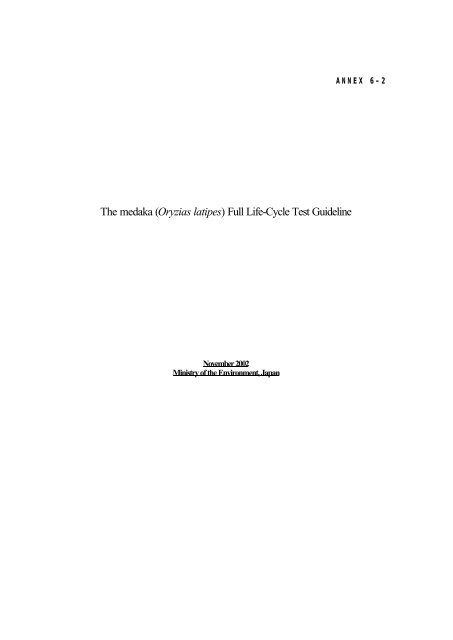
![Presentation Material [PDF 1664KB]](https://img.yumpu.com/23394763/1/190x132/presentation-material-pdf-1664kb.jpg?quality=85)
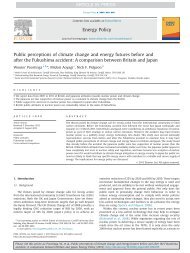
![List of Participants[PDF 221KB]](https://img.yumpu.com/22029974/1/184x260/list-of-participantspdf-221kb.jpg?quality=85)

![Presentation Material [PDF 4494KB]](https://img.yumpu.com/22029884/1/190x143/presentation-material-pdf-4494kb.jpg?quality=85)
